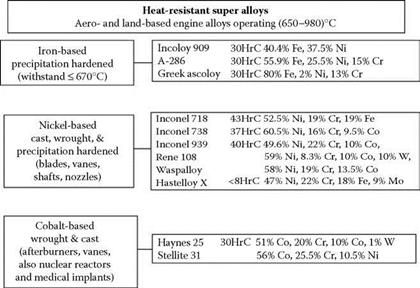Heat-resistant superalloys (HRSA) are based on high levels of nickel, chromium, and/or cobalt. In many cases, iron, as an alloying element, may be almost or entirely absent. These are the workhorses
|
FIGURE 13.6 Major classes and examples of heat-resistant superalloys. |
of the aerospace engine and land-based power generation industries. Their superior ability to retain strength and corrosion resistance at high temperatures allows their use in turbine vanes and blades, and after-burners that operate at temperatures up to 980°C. For major classes and examples of heat — resistant superalloys, see Figure 13.6.
13.4.1 Precipitation-Hardened Iron-Based Alloys
The lowest class of HRSA materials is the precipitation-hardened iron-based alloys discussed before.
13.4.2 Nickel-Based Alloys
The second, and most prolific, group of alloys is the nickel-based superalloys. These are used extensively for blades, vanes, buckets, shrouds, shafts, nozzles, honeycomb, and rotors. The raw material may be supplied as a forging, casting, or as bar stock depending on the application. Blades and vanes, for example, are supplied as castings, usually hollow to reduce weight. Because the grindability is so poor and hence grinding costs high, casting suppliers have improved their technology dramatically over the last decade to produce near-net shapes and reduce grinding processes from ones requiring CDCF grinding to remove up to 10 mm of stock to finish grind processes removing as little as a tenth of this. Some blades are even produced as directionally solidified single crystals to maximize the strength in a particular direction. The material may also be supplied after various heat treatments including annealing, solution treatment, and aging. Many basic material grades may have several levels of heat treatment, each of which significantly affecting its grindability. Nevertheless, all nickel — based alloys share the following properties that make their grindability “difficult”:
• High strength, including dynamic shear strength, retains at the high temperatures seen in grinding.
• Poor thermal conductivity.
• Material structure contains hard carbide for wear resistance and crack arrest.
• Material work hardens during chip formation.
• Extreme sensitivity to heat damage; the so-called “white layer” is very detrimental to component strength in an industry where safety is paramount.
The grindability of nickel-based alloys based on G-ratio and surface quality of chip form is perhaps a twentieth that of carbon steels or gray cast iron; based on stock removal parameter, grindability is about a third. CBN and advanced ceramic grains are becoming increasingly dominant for grinding both nickel — and cobalt-based materials.

